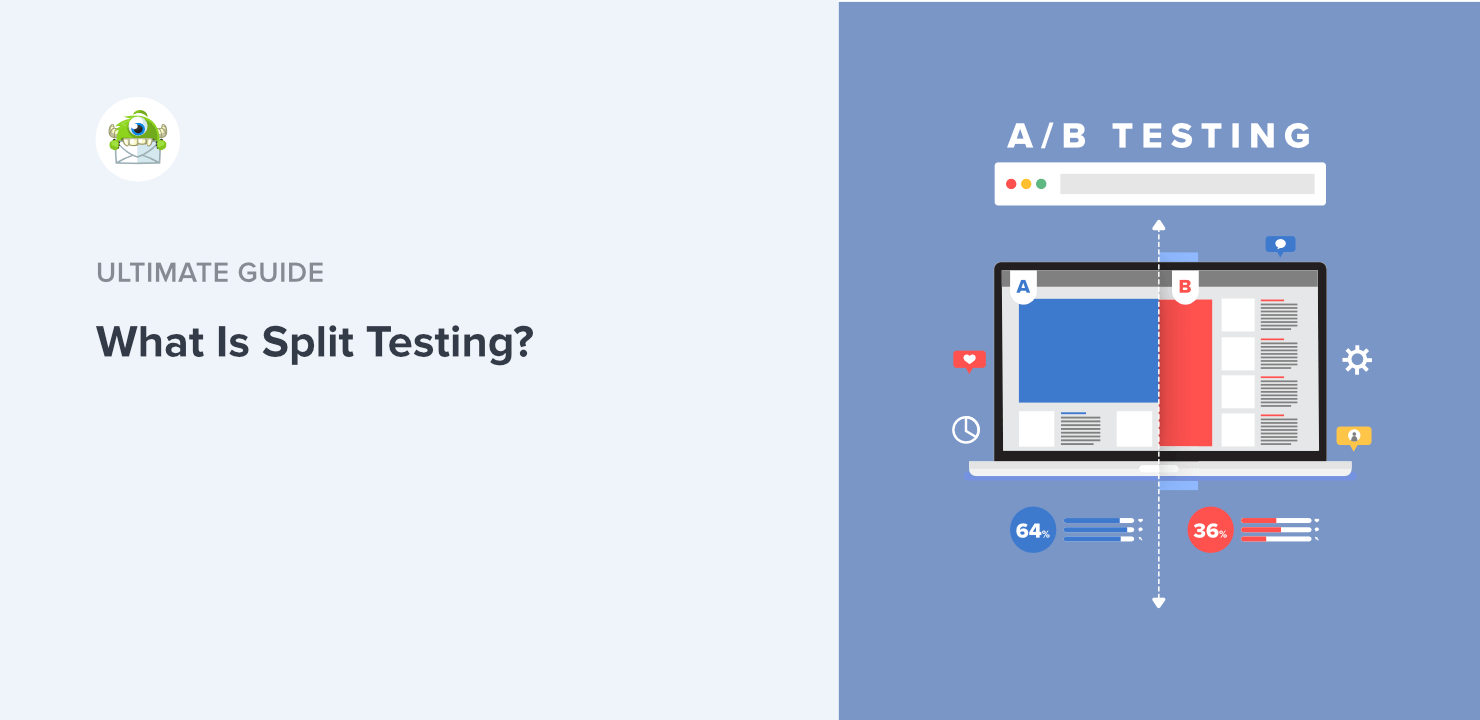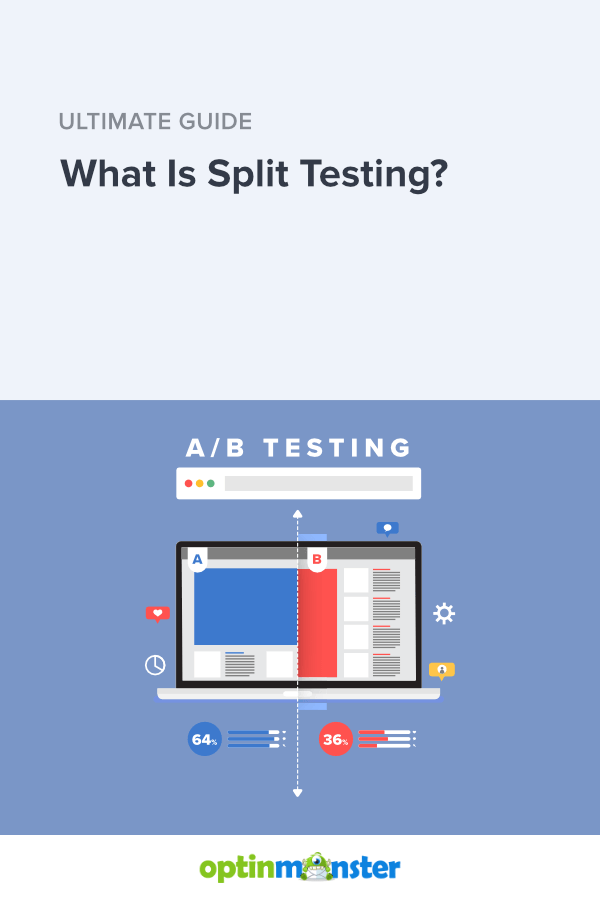TL;DR: Split testing, or A/B testing, lets you compare two versions of your marketing to see which one converts better — so you can stop guessing and start growing.
Split testing is a powerful tool that can significantly improve your digital marketing strategy, but it’s often overlooked or misunderstood. It shows you if your marketing is working and where you can make changes to improve its effectiveness.
In this article, you will learn everything there is to know about split testing.
By the end, you will know how to run split tests to improve your marketing efforts’ returns.
Table of Contents
What Is Split Testing?
Split testing (A/B testing) is a method of comparing two versions of a marketing asset — like a landing page, ad, or email — to see which performs better with your audience.
It’s one of the simplest and most powerful ways to make data-driven decisions. Instead of guessing what might work, you let real user behavior show you what does work.
In a typical split test, you show Version A (the control) to one segment of your audience and Version B (the variation) to another. Then, you compare results — like click-through rates, sign-ups, or purchases — to determine a winner.
While split testing focuses on a single variable at a time, multivariate testing takes it further by analyzing how multiple variables interact. But for most marketers, split testing is the perfect place to start because it’s fast, focused, and often delivers immediate insights.
Key Components of Split Testing
- Control Group and Variation: The original version serves as the control, while the modified version is the variation.
- Metrics: These are the success indicators, such as conversion rate or click-through rate, that you’ll use to measure the outcome.
How to Conduct Split Testing
Here’s a step-by-step guide on how to conduct split testing effectively:
Step 1. Define Your Objective
Start by clearly defining what you want to achieve with your split test. Objectives can range from increasing email open rates, improving click-through rates on a webpage, to boosting conversion rates on a product page. Having a clear goal helps in designing the test and measuring success.
Step 2. Identify the Variable to Test
Choose one variable to test at a time to isolate its impact on your objective. This could be anything from a headline, call to action (CTA) button color, email subject line, or image placement. Testing one variable ensures that any changes in performance can be attributed to that specific modification.
Step 3. Create the Variations
Develop two versions of your asset: the control version (A), which is the current version, and the variation (B), which includes the change you’re testing. Ensure that the variations differ only in the variable being tested to maintain the integrity of the test.
Step 4. Segment Your Audience
Divide your sample size audience randomly into two equal groups to ensure that each group is statistically similar. One group will be exposed to the control version, while the other group will see the variation. This randomization helps eliminate biases and external factors that could skew the split test results.
Step 5. Choose the Right Tool
Select a split testing tool that fits your needs. Tools like Google Optimize, Optimizely, and VWO can help you set up, run, and analyze your tests with ease. Ensure the tool you choose integrates well with your website or marketing platform.
Step 6. Run the Test
Launch your test, allowing both versions to run simultaneously for a set period or until you have collected enough data to achieve statistical significance. The duration of the test can vary depending on your website’s traffic, the size of your email list, and the expected difference in performance between the two versions.
Step 7. Analyze the Test Results
After the test is complete, analyze the data to determine which version performed better in achieving your objective. Look for statistical significance in the results to ensure that the observed differences are not due to chance. Tools typically provide this analysis, showing you which version is the winner.
Step 8. Implement and Learn
If the variation outperforms the control, consider implementing the change permanently. If there’s no significant difference or the control performs better, use the insights gained to inform future tests. Every test, whether successful or not, provides valuable information about your audience’s preferences and behavior.
Step 9. Document and Share Insights
Document the testing process, results, and insights from your split test. Sharing these findings with your team can help inform broader marketing strategies and foster a culture of data-driven decision-making.
Step 10. Iterate
Split testing is an iterative process. Based on the insights gained from one test, you can develop new hypotheses and continue testing to optimize further and improve your marketing assets.
By following these steps, you can effectively conduct split testing to make data-driven decisions that enrich your marketing efforts and improve user experience.
Best Practices for Split Testing
Keep Tests Simple: Focus on one variable at a time to clearly understand its impact. Testing multiple variables simultaneously can muddy the waters, making it difficult to pinpoint what led to changes in user behavior.
Ensure Tests Run Long Enough: Patience is key. Running a test for a sufficient duration ensures that you collect enough data to make informed decisions. A test I ran on email send times took weeks to show clear trends, but the insights gained were invaluable for optimizing our email marketing strategy.
Avoid Common Pitfalls: Changing your test mid-way or not waiting for statistical significance can lead to misleading conclusions. It’s also important to avoid testing too many variables at once, as this can complicate the analysis.
Continuous Learning: Every test, whether successful or not, is a learning opportunity. Document your findings and use them to inform future tests and strategies.
Advanced Split Testing Strategies
Advanced split testing strategies provide deeper insights into user behavior and preferences. Here’s a concise overview of some sophisticated approaches:
1. Multivariate Testing
Test multiple variables and their combinations simultaneously to understand their collective impact on user behavior. Ideal for complex pages, requiring more traffic for statistical significance.
2. Sequential Testing
Run a series of tests one after the other, using insights from one test to inform the next. This methodical approach allows for deeper optimization over time.
3. Personalization Testing
Create tailored content for different audience segments based on behavior, demographics, or past interactions. Compare personalized messages against generic versions to drive better engagement.
4. Full Funnel Testing
Examine the entire user journey from engagement to conversion. Optimize the path to purchase by testing variations across multiple touchpoints.
5. Behavioral Email Segmentation
Segment your audience based on their behavior and test different messaging for each group. This strategy enhances the effectiveness of email campaigns.
6. AI and Machine Learning
Use AI and machine learning to predict successful variations, identify testing opportunities, and automate the optimization process.
7. Cross-Channel Testing
Test messaging consistency across different marketing channels (e.g., email, social media, PPC) to understand how they work together to drive conversions.
Implementing these advanced strategies requires a clear hypothesis, sufficient website traffic or data for significance, and the right tools for analysis. Prioritize user experience to ensure testing enhances rather than detracts from user satisfaction.
Best Split Testing Tools
Here’s a list of some of the best split testing tools available, each offering unique features to suit different needs:
| Tool | Use Case | Notable Features | Ideal For |
|---|---|---|---|
| OptinMonster 🏆 | A/B testing opt-in forms | Drag-and-drop builder, campaign triggers, audience targeting, analytics | Our top recommendation for A/B testing opt-in forms |
| Optimizely | Full-scale experimentation | A/B and multivariate testing, feature flagging, personalization, mobile testing | Enterprise marketing teams |
| VWO | Website & funnel optimization | Split URL testing, heatmaps, visitor recordings, form analytics | UX designers, CRO teams |
| Unbounce | Landing page testing | Landing page builder with built-in A/B testing, AI copywriting | PPC marketers, solopreneurs |
| Convert | Privacy-focused A/B testing | GDPR-compliant, fast loading, multivariate and multipage testing | EU businesses, privacy-conscious teams |
Each of these A/B testing tools brings something different to the table. We selected them based on ease of use, test variety (A/B, multivariate, split URL), integration capabilities, and support for conversion optimization.
If you’re just starting out or focused on growing your email list, OptinMonster is our top pick — it’s built for marketers who want quick wins without needing a developer.
1. Optimizely

Features: Optimizely is one of the most popular tools for A/B testing, offering a robust platform that supports multivariate testing, personalization, and mobile app testing. It’s designed for ease of use, allowing marketers to set up and run tests without needing deep technical knowledge.
2. VWO (Visual Website Optimizer)

Features: VWO provides a comprehensive suite of testing and optimization tools, including A/B testing, split URL testing, and multivariate testing. It also offers features for visitor behavior analysis, such as heatmaps and session recordings, to inform testing strategies.
3. Unbounce

Features: Unbounce specializes in landing page optimization and offers A/B testing as part of its platform. It’s particularly useful for marketers looking to boost conversion rates on landing pages with easy-to-use drag-and-drop functionality.
4. Convert

Features: Convert offers advanced A/B testing and multivariate testing capabilities, with a focus on ease of use and data privacy. It’s known for its excellent customer support and GDPR compliance, making it a good choice for businesses concerned about user privacy.
Conclusion
Mastering split testing is crucial for optimizing your strategies and improving outcomes. OptinMonster emerges as a standout tool, offering a comprehensive suite of features for conversion optimization.
It simplifies creating engaging opt-ins and conducting A/B tests, helping you make data-driven decisions to enhance user experience and boost conversion rates.
With OptinMonster, you can easily personalize your campaigns and see real results. In essence, leveraging OptinMonster’s capabilities can significantly elevate your digital marketing efforts, ensuring you stay ahead in the game.
Here’s one of our favorite split testing case study:
Social Media Examiner split tested its opt-in forms regularly to increase its subscribers by 250,000, a 66% increase in daily subscriber signups. The site continued tweaking to see what other improvements it could engineer.
More on Conversion Optimization:
- The Ultimate eCommerce Optimization Guide: 13 Steps to Instantly Boost Revenue
- What Is Conversion Rate Optimization (CRO)? Complete Beginner’s Guide
- Google Analytics 101: How to Track Your Conversions (Step-by-Step)
- 31 Call to Action Examples + How To Write an Effective CTA
- 11 Best Marketing Automation Software for Small Businesses
- 12 Tips to Reduce Bounce Rate and Boost Your Conversions
- SEO Made Easy—Ultimate Guide to Explode Your Traffic
FAQ
1. Why Should You Run a Split Test?
Here are some benefits that stand out:
Improved User Experience: By understanding what resonates with your target audience, you can tailor experiences that meet their needs and preferences, leading to a more engaging and satisfying interaction with your brand.
Increased Conversion Rates: One of my earliest successes with split testing involved tweaking a call-to-action button on the homepage. By changing its color and text, we saw a 20% increase in sign-ups. It was a small change with a significant impact, highlighting how minor adjustments can lead to significant improvements in conversion rates.
Enhanced Content Effectiveness: Split testing can reveal what types of content your audience prefers, allowing you to produce more of what works and less of what doesn’t, thereby maximizing your content marketing efforts.
Cost Efficiency: By making data-driven decisions, you minimize the risks associated with large-scale changes, ensuring that resources are allocated efficiently and effectively.
2. When to Use Split Testing?
Split testing isn’t a one-size-fits-all solution; it’s most effective when used under the right circumstances. Here are scenarios where split testing shines:
Email Marketing Campaigns: From subject lines to email layouts, split testing can help you refine your approach for better engagement.
Website Redesigns: Before overhauling your entire site, test page elements individually to understand their impact on user behavior.
Landing Page Optimization: This is where I’ve seen the most dramatic results, as even minor tweaks can significantly affect conversion rates.











Add a Comment